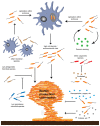Biofilms: the stronghold of Legionella pneumophila
- PMID: 24185913
- PMCID: PMC3856027
- DOI: 10.3390/ijms141121660
Biofilms: the stronghold of Legionella pneumophila
Abstract
Legionellosis is mostly caused by Legionella pneumophila and is defined as a severe respiratory illness with a case fatality rate ranging from 5% to 80%. L. pneumophila is ubiquitous in natural and anthropogenic water systems. L. pneumophila is transmitted by inhalation of contaminated aerosols produced by a variety of devices. While L. pneumophila replicates within environmental protozoa, colonization and persistence in its natural environment are also mediated by biofilm formation and colonization within multispecies microbial communities. There is now evidence that some legionellosis outbreaks are correlated with the presence of biofilms. Thus, preventing biofilm formation appears as one of the strategies to reduce water system contamination. However, we lack information about the chemical and biophysical conditions, as well as the molecular mechanisms that allow the production of biofilms by L. pneumophila. Here, we discuss the molecular basis of biofilm formation by L. pneumophila and the roles of other microbial species in L. pneumophila biofilm colonization. In addition, we discuss the protective roles of biofilms against current L. pneumophila sanitation strategies along with the initial data available on the regulation of L. pneumophila biofilm formation.
Figures



References
-
- Carratala J., Fernandez-Sabe N., Ortega L., Castellsague X., Roson B., Dorca J., Fernandez-Aguera A., Verdaguer R., Martinez J., Manresa F., et al. Outpatient care compared with hospitalization for community-acquired pneumonia: A randomized trial in low-risk patients. Ann. Intern. Med. 2005;142:165–172. - PubMed
-
- Yu V.L., Plouffe J.F., Pastoris M.C., Stout J.E., Schousboe M., Widmer A., Summersgill J., File T., Heath C.M., Paterson D.L., et al. Distribution of Legionella species and serogroups isolated by culture in patients with sporadic community-acquired Legionellosis: An international collaborative survey. J. Infect. Dis. 2002;186:127–128. - PubMed
Publication types
MeSH terms
Grants and funding
LinkOut - more resources
Full Text Sources
Other Literature Sources

